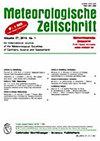Cb‑Fusion–预测雷暴单元长达6小时
IF 1.7
4区 地球科学
Q4 METEOROLOGY & ATMOSPHERIC SCIENCES
引用次数: 1
摘要
雷暴作为一种恶劣的天气现象,会给人类社会造成人员伤亡和经济损失。对这些天气事件的可靠预测将有助于避免或至少减轻这种损害。然而,到目前为止,雷暴的预测仍然是一个挑战,尤其是对于一小时及以上的交付周期。在这项研究中,我们提出了一种在几个小时内预测深对流的方法:Cb Fusion使用数据融合技术,将观测、即时预报和数值天气预测中的多个来源的数据以高更新率混合在一起,提前6小时估计中欧部分地区雷暴发生的可能性。Cb Fusion被设置为近乎实时地运行。基于2019年4月至10月期间收集的1743小时雷暴观测,对Cb融合的技能进行了评估。雷暴大小分为三类:覆盖面积大于5000平方公里的“大”雷暴,覆盖面积在5000平方公里至500平方公里之间的“中等”雷暴,以及覆盖面积小于500平方公里的‘小’雷暴。与仅通过数值模型进行的雷暴预测相比,Cb Fusion将各种来源的数据相结合,可以显著提高预测能力。研究表明,对于“中等”和“大”规模雷暴,该预测在长达3小时的提前期内是可靠的(POD中值为0.6–0.9),但对于“小”规模雷暴和3至6小时之间的提前期(POD中值0.05),该预测几乎没有技巧。有人认为,Cb Fusion在为各种用户预测雷暴方面提供了有意义的改进。本文章由计算机程序翻译,如有差异,请以英文原文为准。
Cb‑Fusion – forecasting thunderstorm cells up to 6 hours
As a severe weather phenomenon, thunderstorms can cause casualties and economic loss to the human society. A reliable forecast of these weather events would help to avoid or at least mitigate this damage. To date, the forecasting of thunderstorms however is still a challenge, especially for lead times of one hour and beyond. In this study we present a methodology to forecast deep-convection for several hours lead time: Cb-Fusion estimates the likelihood of thunderstorm occurrence for up to 6 hours in advance over a part of Central Europe, using a data fusion technique that blends data of multiple sources from observations, nowcasts, and numerical weather predictions with a high update rate. The Cb-Fusion is set up to operate in near real time. The skill of Cb-Fusion is evaluated based on 1743 hours of thunderstorm observations collected during the months April to October, 2019. Three categories of thunderstorm size have been distinguished: ‘large’ for a coverage area larger than 5000 km2, ‘medium’ for a coverage area between 5000 km2 and 500 km2, and ‘small’ for a coverage area smaller than 500 km2. Compared to thunderstorm forecasts from numerical models alone, the combination of data from various sources by Cb-Fusion results in a significantly better forecast skill. The study reveals that the forecast is reliable for up to 3 hours lead time for ‘medium’ and ‘large’ scale thunderstorms (median POD of 0.6 – 0.9) but little skill is found for ‘small’ scale thunderstorms and lead times between 3 and 6 hours (median POD of 0.05). It is argued that Cb-Fusion provides meaningful improvements in forecasting thunderstorms for various users.
求助全文
通过发布文献求助,成功后即可免费获取论文全文。
去求助
来源期刊

Meteorologische Zeitschrift
地学-气象与大气科学
CiteScore
2.80
自引率
8.30%
发文量
19
审稿时长
6-12 weeks
期刊介绍:
Meteorologische Zeitschrift (Contributions to Atmospheric Sciences) accepts high-quality, English language, double peer-reviewed manuscripts on all aspects of observational, theoretical and computational research on the entire field of meteorology and atmospheric physics, including climatology. Manuscripts from applied sectors such as, e.g., Environmental Meteorology or Energy Meteorology are particularly welcome.
Meteorologische Zeitschrift (Contributions to Atmospheric Sciences) represents a natural forum for the meteorological community of Central Europe and worldwide.
 求助内容:
求助内容: 应助结果提醒方式:
应助结果提醒方式:


